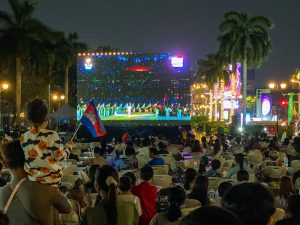Among the countries of Southeast Asia, few share more in common culturally than Thailand and Cambodia. In addition to being neighbors, both countries are predominantly Theravada Buddhist, with 93 percent of Thai people and 95 percent of Cambodians professing this faith. The two countries also share similar cultural activities, such as kickboxing and Apsara dancing, even though these often go by different names (in Cambodia, kickboxing is known as Kun Khmer, while Thais refer to it as Muay Thai). Both countries also share the national mantra of “nation-religion-king,” as well as similar social norms, culinary traditions, and socio-ethnic features. Their languages are also written in scripts that share the same origin. Nevertheless, these similarities have historically been a cause more of conflict than of cooperation between the two countries.
Cambodians and Thais frequently make claims that their respective nations are the “original” owners of these cultural heritages, a subject over which they often attack, bully, and insult each other via social media. Those negative opinions were reinforced in the run-up to the 32nd Southeast Asian Games (SEA Games), which are being held this month in Cambodia.
At the opening of the SEA Games, Cambodia showcased its culture, including Angkor Wat, Apsara dances, sacred tattoos (Sak Yon), and the martial art of Kun Lbokator. As most of these activities also have Thai versions, there have been increasing tensions between Cambodia and Thai netizens over the origins and ownership of these cultural activities, which have broadened out into general nationalist antagonism. In one video posed to social media, a group of Cambodians are seen chanting “Goodbye Thailand” to the Thai volleyball team, after it lost to Cambodia at the SEA Games on May 7 this year. Some social media influencers have even built their popularity by producing and sharing content encouraging this sort of nationalist sentiment.
This sentiment has emerged in particularly sharp form following the controversy over which nation is the original owner of traditional kickboxing. Prior to the SEA Games, there was outrage in Thailand over the decision of the Cambodia Boxing Federation to name the kickboxing event “Kun Khmer” rather than “Muay Thai” for the upcoming Games. This led to the famous Thai boxer Buakaw Banchamek stating, “Do not worry about Cambodia using the name ‘Kun Khmer’ because Cambodia is the host of the SEA Games and it is only a Southeast Asian sport, while Muay Thai is an Olympic and world-class sport.” The statement has been endorsed by many Thai people online, and has triggered outrage and hatred toward Buakaw among many Cambodians. It even prompted a Cambodian tycoon to promise a villa and car to any Cambodian who could beat Buakaw in the ring.
This sniping obviously runs counter to the spirit of sport, which is to maintain cooperation and reach a common understanding. The current trend could harm people-to-people relations between the two countries. Indeed, it even has the potential to have severe consequences for economic and political relations between Cambodia and Thailand.
While the SEA Games controversy has been merely a war of words between individual citizens who do not officially represent their own countries, the implications cannot be underestimated. For nearly three decades, cultural factors have shaped relations between Cambodia and Thailand, and in some instance have led to armed conflict and violence.
This was exemplified by the 2003 dispute over the origin of Angkor Wat. In January of that year, demonstrations erupted in Phnom Penh that led to the destruction of the Thai Embassy and the sacking of Thai-owned restaurants, businesses, and hotels. The riots followed comments by Suwanan Kongying, a Thai actress, who said that she would only perform in Cambodia again when Cambodian “returned” Angkor Wat, the country’s most famous tourist destination and a potent symbol of Cambodian nationalism, to Thailand. The riot led to a breaking of diplomatic relations between the two countries. Consequently, the Cambodian government paid Thailand $6 million in compensation for the damage, and relations were restored.
Another example of this is the case of Preah Vihear, an 11th-century Angkorian temple perched on the border between the two countries. Following UNESCO’s decision to list the temple as a World Heritage Site in 2008, Thailand moved its troops to the Cambodia-Thai border, claiming that the land surrounding the temple belonged to Thailand. The background to this was the political polarization between Thailand’s “red shirts,” the supporters of former Prime Minister Thaksin Shinawatra, and the “yellow shirts,” who opposed him and were favored by the army and conservative establishment. Unhappy with UNESCO’s decision, the yellow shirts protested in Bangkok and the province of Sisaket, close to Preah Vihear temple. During the demonstrations, three Thai protestors gained access to the temple; Thailand sent its troops into the surrounding area, on the pretext of protecting the protesters, and refused to leave. When the Cambodian government sent its own troops to the border, it resulted in a minor military confrontation that led to the severing of diplomatic relations, the deaths of 28 people, and the temporary displacement of nearly 100,000 villagers from the area.
These two examples showed how cultural affinities have played a critical role in the relations between Cambodia and Thailand. But such rivalries could yield undesirable outcomes for the relations between the two countries. For this reason, the two governments should take proactive steps to prevent future outrages. Chief among them is to encourage social media influencers, artists, and public figures to avoid triggering nationalist sentiments against the other country. Cambodia and Thailand have to live next to each other, and the only way forward is cooperation and peace based on friendly people-to-people relations.

































